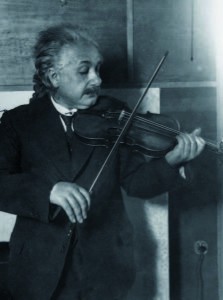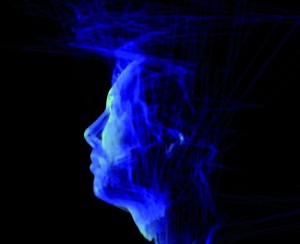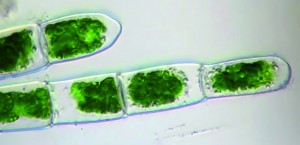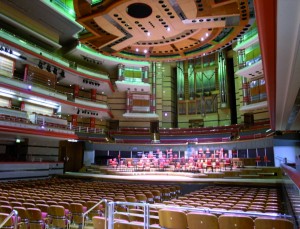WEDNESDAY, 15 MAY 2013
At first glance, science and music seem to have little in common with one another. Scientific research is rational, detail oriented and protocol- driven, the complete opposite of highly imaginative abstract musical creations. However, by examining these two disciplines more carefully, similarities start to emerge. There are two elementary components in music, composition and performance—the first is highly creative, while the latter requires accuracy. For instance, a musical composer must be both imaginative and precise when writing a score. In doing research, scientists must also be creative to design novel experiments or techniques but also accurate when generating and analysing their data.Interestingly, some of the most distinguished musicians possess strong scientific backgrounds, suggesting an overlap in the skills required to succeed in music or science. Brian May, the guitarist of Queen, completed his PhD in astrophysics on light reflecting from interplanetary dust. Meanwhile, Brian Cox is probably the only pop star to become a celebrity later on for his scientific contribution. Prior to gazing at the stars and working on theoretical physics, the University of Manchester Professor was a keyboardist for the group D:Ream and even entered the UK charts with the song “Things Can Only Get Better”. Other examples include Ladytron vocalist/geneticist Dr Mira Aroyo and Dexter Holland, who gave up his PhD studies in molecular biology to focus on The Offspring. If you think the latter is pretty cool for a punk rock front man, you should also consider Bad Religion lead singer Dr Greg Graffin, who currently teaches life sciences and palaeontology at the University of California, Los Angeles.
Of course, artists do not need a PhD in order to embrace science. For many, technological advances have served as a source of lyrical inspiration that deals with the loss of humanity in an increasingly machine-dominated world. Others utilise scientific achievements to create original presentations. For example, in their video for “House of Cards”, Radiohead used 3D plotting techniques to visualise information about shapes and the relative distances of objects instead of traditional cameras. This artistic fascination with science should not come as a surprise. Undoubtedly, a memorable musical performance is characterised by emotional drive and passion. However, underneath the aesthetic appeal of melancholic melodies or uplifting rhythms, there is a clearly defined structure and methodology. Classical concertos typically consist of three movements, with a fast-slow-fast scheme, while pop songs have an introduction, verses and a chorus. In all performances, pitch, duration, tempo, and dynamics are accurately encoded through musical notation symbols and when musical arrangement deviates from standard models it is referred to as ‘experimental’, drawing parallels with the robust experimental work undertaken by scientists to explore innovative ideas. Beyond the artists, the modern music industry relies heavily on the use of technology, from sound engineering to optimising concert hall acoustics and creating visual projections to accompany live performances.
But is the reverse also true, do scientists significantly indulge in music? Some of the most admired human minds in history have expressed a clear enthrallment with music, and in some cases this has been paramount for important inventions. Walther Nernst, who received the Chemistry Nobel Prize for devising the third law of thermodynamics, was the first to fashion electronically amplified instruments. John Pierce combined his engineering and musical abilities to construct the first computers capable of making music. In addition, the study of electron harmonics by Louis de Broglie and others was the foundation for the development of magnetic resonance imaging.
However, perhaps the most illustrative example is none other than Albert Einstein, a keen violist and pianist, who argued that “imagination is more important than knowledge”. In Einstein’s view, musical engagement functions as an essential recreational process that allows scientific innovation. He believed that all scientific breakthroughs are the result of intuition and inspiration, rather than logic or mathematics. He was so certain of the creative value of musical engagement, that he explicitly stated it was the driving force behind conceiving his theory of relativity. Another Nobel Prize winner, Max Planck, was also musically gifted, playing the piano, organ and cello and even composing operas. It was the realisation that electrons, like musical strings, have harmonic frequencies due to their perinuclear vibration, that led to Planck’s quanta theory of electromagnetic radiation. Planck and Einstein collaborated closely on physics puzzles and indeed often played music together at Planck’s house.
Scientific research can be intense and somewhat isolating, so musically-mediated relaxation can provide a less demanding, creative outlet. Moreover, scientific innovation seems to be correlated with creative activities outside science. The physiologist Root-Bernstein has shown that scientists are more inclined than the general public to play a musical instrument and that scientists engaging in the arts are more likely to be Nobel laureates. He suggested that successful scientists are highly versatile and able to apply their talents across a range of disciplines. In this way, a plethora of musical skills can be fruitfully integrated in science. Such abilities may range from enhanced hand-eye coordination, pattern recognition, analogising, visual imagination and aesthetic sensibility to improved analytical, communication and team-working skills. Consistent with this, studies have demonstrated that students who regularly listen to Mozart or play instruments score higher on visual problem-solving tasks.
In more recent times, the combined efforts of musicians and scientists have produced some interesting and amusing results. In 2011, the British Academy of Sound Therapy and the band Marconi Union created “Weightless”, a euphoric composition of carefully arranged harmonies, low ambient tones and trance-inducing patterns that is allegedly the most relaxing song ever. It is thought to be so effective at inducing sleep that it is recommended that the song should not be listened to whilst driving. In another inspired application, biologists studying the life cycle of algae species from the English Channel used music as an alternative way of representing their large datasets. To their amazement, when the researchers converted measurements of interest into musical notes, they were presented with what sounded suspiciously like songs. For instance, in the resulting melody “Bloom”, low or high notes correspond to decreased or increased microbial abundances, while chord progression was derived from day length and chlorophyll concentration in the water. Importantly, this type of analysis helped researchers identify previously intangible connections between studied parameters. Such examples demonstrate how science and music are simply different manifestations of an idea and how the combination of the two allows substantial progress to be made. Similar approaches have led to arrangements describing the behaviour of the Higgs boson, as well as star data collected by NASA’s Kepler telescope (the latter being a reggae tune).
It is evident that music and science foster one another, so naturally, a number of educational initiatives have embraced this interconnection. In 2009, John Boswell launched the ambitious Symphony of Science project, designed to deliver scientific knowledge to the public in musical form, while NASA organises numerous events as part of their Music and Astronomy Under The Stars program. Teachers increasingly incorporate music into their tutoring methods and many institutions now offer specialised or conjunctional courses, such as the Physics and Musical Performance degree at the Royal College of Music. Finally, the internet thrives with inspired scientific song collections (including “Pi”, “Elements”, “GTCA” and “The Sun is a Mass of Incandescent Gas”), which entertain but also assist learning. Hopefully, such developments will further promote the synergy between music and science, an interaction that has proved beautiful and valuable throughout history and will undoubtedly continue to do so.
Christoforos Tsantoulas is a postdoctoral researcher at the Department of Pharmacology




